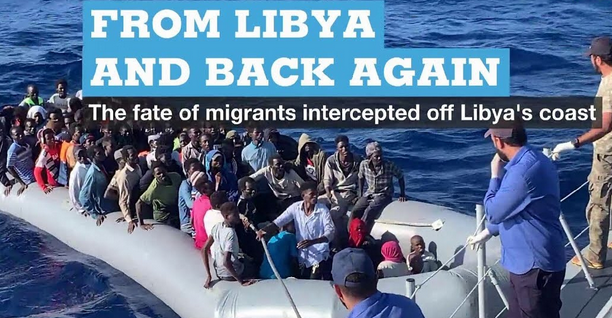Photos: YouTube
(Brussels) – The use by the EU’s border agency, Frontex, of aerial surveillance to enable the Libyan Coast Guard to intercept migrant boats, knowing that migrants and asylum seekers will face systematic and widespread abuse when forcibly returned to Libya, makes Frontex complicit in the abuse, Human Rights Watch and Border Forensics said in a multimedia research feature released today.
Using data analysis and research testimony, the interactive web feature “Airborne Complicity: Frontex Aerial Surveillance Enables Abuse” documents the role that Frontex-chartered aircraft – several planes and a drone – play in detecting migrants’ boats in the central Mediterranean and their subsequent interception by Libyan forces. The aircraft, operated by private companies, transmit video feeds and other information to a situation center in Frontex headquarters in Warsaw, where operational decisions are taken about when and whom to alert about migrants’ boats. While Frontex argues that aerial surveillance saves lives, the evidence gathered by Human Rights Watch and Border Forensics demonstrates it is in service of interceptions by Libyan forces, rather than rescue by the civilian rescue organizations or merchant ships that also operate in the area.
“By alerting Libyan authorities about boats carrying migrants, knowing those migrants will be returned to atrocious treatment, and despite having other options, Frontex is complicit in the abuse,” said Judith Sunderland, associate Europe and Central Asia director at Human Rights Watch. “Frontex’s rhetoric around saving lives remains tragically empty as long as the border agency doesn’t use the technology and information at its disposal to ensure that people are rescued promptly and can disembark at safe ports.”
The analysis of available data supports the conclusion that the EU border agency’s approach is designed not to rescue people in distress but to prevent them from reaching EU territory, the organizations said. The statistics indicate that Frontex’s use of aerial assets under its current strategy has not had a meaningful impact on the death rate. However, there is a moderate and statistically significant correlation between its asset flights and the number of interceptions performed by the Libyan Coast Guard. On days when the assets fly more hours over its area of operation, the Libyan Coast Guard tends to intercept more vessels.
On November 29, the European Center for Constitutional and Human Rights (ECCHR) filed a complaint before the International Criminal Court (ICC) arguing European responsibility for crimes against humanity committed against migrants and refugees in Libya.
Border Forensics and Human Rights Watch reconstructed the events of July 30, 2021, when several boats carrying migrants were intercepted by the Libyan Coast Guard. This was done by cross-referencing official and open-source data, including drone and plane flight tracks, together with information from Sea-Watch, a civilian rescue organization with a ship in the water and a plane in the air that day, Alarm Phone, a hotline for migrants in distress at sea, and the testimony of survivors.
Frontex uses a remotely operated, unarmed Heron drone designed for intelligence gathering and surveillance because it can fly for long hours off the Libyan coast. The drone’s tracks that day indicate it most likely detected at least two boats later intercepted by the Libyan Coast Guard. The rescue ship Sea-Watch 3 witnessed by chance the interception of one of them. It had not received any distress alert via Frontex.
The failure to inform rescue organizations about boats in distress or to issue mayday alerts to all vessels in the area illustrates Frontex’s willfully narrow interpretation of distress, the organizations said. Doing so only in cases where there is risk of imminent loss of life conflicts with relevant maritime law and the EU regulation on maritime border surveillance, as well as consensus views from the UN High Commissioner for Human Rights and the UN High Commissioner for Refugees (UNHCR).
According to Frontex, it has issued 21 mayday alerts in the central Mediterranean between January 2020 and April 2022, a tiny fraction of the boats sighted by its aerial surveillance. Frontex says there were 433 detections by aerial surveillance in the central Mediterranean in 2021 alone. That year, Frontex facilitated Libyan Coast Guard operations that resulted in the forced return of approximately 10,000 people: almost one third of the more than 32,000 people disembarked in Libya.
Frontex’s lack of transparency makes it difficult to verify the facts and impedes accountability, the organizations said. In processing 27 of 30 freedom of information requests submitted – the others are pending – Frontex identified thousands of relevant documents but released only 86 of them. Many were heavily redacted. Frontex denied requests to visit the situation center in Warsaw and to speak with operational staff.
“Faced with Frontex’s fundamental opacity, we have analyzed a vast set of flight tracking and other data to reconstruct its activities in the sky,” said Giovanna Reder, Border Forensics’ lead investigator on this project. “On July 30, 2021, alone, our analysis strongly suggests that the Frontex drone played a key role in returning potentially hundreds of people to abuse. The border agency and EU member states should be held accountable for this.”
Aerial surveillance forms a central plank of the EU’s strategy to prevent migrants and asylum seekers from reaching Europe by boat, while removing itself spatially, physically, and legally from its responsibilities. European authorities have established an extensive yet tight-knit web of aerial surveillance over the central Mediterranean as they have progressively withdrawn Frontex and other EU vessels from the area, handed over responsibility to Libyan forces, and obstructed the vital work of nongovernmental rescue groups.
Frontex emphasizes its obligation under maritime law to alert competent coastal authorities about situations of distress at sea, but this obligation should be considered in conjunction with its obligations under regional and international human rights law, in particular its obligations with respect to the right to life, the prohibition against torture and cruel, inhuman, and degrading treatment or punishment, and the corollary prohibition on refoulement to the threat of torture, persecution, and other serious harm under human rights and refugee law.
As long as Frontex operations are designed to enable interceptions by Libyan forces, the border agency and the EU should be held accountable for their role in the abuses suffered by people returned to Libya, the organizations said.
Frontex should put in place effective measures to fulfill its obligation to assess whether its activities, including aerial surveillance, violate fundamental rights. This should include being more transparent and accountable about its operations.
The EU should fundamentally reorient its migration policy to enable safe and legal pathways and reset its activities in the central Mediterranean and cooperation with Libyan authorities to make sure people are not returned to places where they would face the risk of abuse, lack of access to international protection, and inhuman and degrading conditions of detention.
In the meanwhile, Frontex, with support from the EU and all member states, should use aerial surveillance to support meaningfully rescue at sea and to prevent the risk that people will be taken to Libya. Frontex, Italy, and Malta should alert all vessels in the vicinity of a boat in need of assistance, based on a broad definition of distress that considers all overcrowded, unseaworthy boats in open waters to be in peril.
Frontex and member states should deploy their own ships in areas where they deploy aircraft so they can respond directly and quickly to situations of distress, and they should stop harassing nongovernmental groups that are doing that. Unless called away by other emergencies, planes and drones being used for surveillance should remain at the scene when they detect boats to monitor their situation and document rescue or interception operations.


















